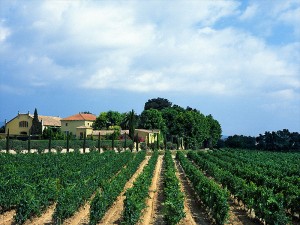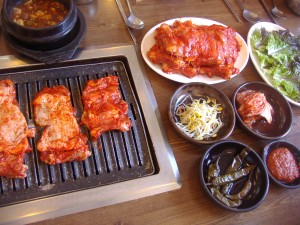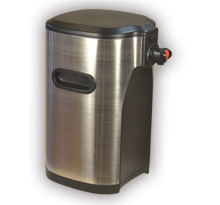by Lorri | Jul 17, 2013 | UnCorked
 My loyalty lies with American winemakers but I still have a deep affection for the wines of Spain. After our last trip to Spain I wrote about the first and foremost wine known by most when we think of Spain – sherry. But during our recent trip I looked around at what the people of Spain were drinking. Just as we have our favorite standbys of chardonnay and merlot, Spanish wine drinkers have their safe bets too.
My loyalty lies with American winemakers but I still have a deep affection for the wines of Spain. After our last trip to Spain I wrote about the first and foremost wine known by most when we think of Spain – sherry. But during our recent trip I looked around at what the people of Spain were drinking. Just as we have our favorite standbys of chardonnay and merlot, Spanish wine drinkers have their safe bets too.
ALBARINO
The albarino varietal is one of Spain’s best-kept wine secrets. You could compare it to the viognier in some ways but lighter, with more acidity. The light and refreshing wine is an ideal match for Spain’s local-catch seafood dishes. The grapes are grown and the wine produced in the northwest corner of Spain in the Rias Baixas region. Most of Spain’s growing regions can best be described as hot, hotter and downright unbearable. This region is cooler and has an abundance of rainfall, giving this wine its delicate, lively aromatic characteristics.
THE VALUE
- 2012 Ramon Bilbao Albarino, Spain (about $15 retail)
THE SPLURGE
- 2011 La Cana Albarino, Spain (about $20 retail)
VERDEJO
Verdejo (ver-DAY-ho) is Spain’s answer to sauvignon blanc. In the Andalusia region it was on every restaurant wine list, in every wine shop and even in the supermarkets. In most restaurants it’s the varietal used as the house wine, with a listing of “Vino blanco.” The grape is indigenous to the Rueda region in northeastern Spain along the Douro River. The style can be crisp and grassy, similar to sauvignon blanc,or richer, much like a California unoaked chardonnay. It is a style of wine easily paired with a wide range of foods.
THE VALUE
- 2011 Tapena Verdejo, Spain (about $11 retail)
THE SPLURGE
- 2011 Nisia Old Vine Verdejo, Spain (about $16 retail)
CAVA
When in Spain, there is no other ideal bubbly than Spanish Cava. It generally has more acidity than other sparkling wines and therefore it pairs with many cuisines. We had it as an aperitif, with seafood, paella and even pasta. It’s produced in the Penedes region of Catalonia using the same winemaking method as the honored Champagne, but with indigenous grapes. The result is a refreshing, sparkling wine at half the price of most Champagne.
THE VALUE
- NV Segura Viudas Brut Reserva, Spain (about $12 retail)
THE SPLURGE
- NV Sumarroca Cava Brut, Spain (about $19 retail)
by Lorri | Jul 10, 2013 | Tips, UnCorked
 As I write this column I have just returned home from a long, relaxed stay in Spain with my family. (Many columns to come about my adventures and discoveries in the Iberian peninsula). As I made my way through the numerous airports I realized my wine travel tips might be immediately relevant to those of you with suitcases already packed and travel confirmed.
As I write this column I have just returned home from a long, relaxed stay in Spain with my family. (Many columns to come about my adventures and discoveries in the Iberian peninsula). As I made my way through the numerous airports I realized my wine travel tips might be immediately relevant to those of you with suitcases already packed and travel confirmed.
For those of us who travel frequently it’s common to keep a wine opener in our bags. I always keep one in my briefcase, because on one trip years ago the only help the front desk of my hotel could offer was a metal fork. (Oddly enough, with patience and precision, I actually got the fork to work.)
When traveling by plane, make sure you pack the opener in your checked luggage. A wine opener is only handy to have until it is confiscated during the security screening. It happened to me this trip and I must say it was painful to watch as one of my favorite openers was haphazardly tossed into the box of the abyss.
Because we can now carry only very small amounts of liquids on the plane, bringing back bottles of wine poses special challenges. In the past, those few sacred bottles were easily packed in carry-on bags where they wouldn’t be crushed, jostled or otherwise in danger of breaking. Now you need more planning in order to arrive home with your purchase. You can try the old (and risky) strategy of wrapping the bottle in a thick sock, packing it in the center of your suitcase wrapped with clothes and hoping it doesn’t break or leak by the time you reach your final destination. But there’s a better way. There are many options for protecting your bottles in checked luggage. Several of my favorites are the Vinni-Bag (vinnibag.com), Winehug (winehug.com) and Wine Skin (wineskin.net). These products basically create a sturdy air cushion around the bottles. The drawback is they are bulky and take up precious space in a suitcase. The worst part of my trip was the realization that mine were still sitting on my desk at home.
As I was collecting my baggage in customs I noticed that someone else had a red bag with a large logo depicting a wine bottle with wings. After some research I discovered it’s called The Wine Check, and it is what I think could be a smart option for getting our precious cargo safely home. It looks like a square rolling suitcase but is specially designed to hold one case (12 bottles) of wine while staying under the 50-pound limit most airlines allow. I watched the durability test video on the website and was impressed with the results.
If your travel involves wine and an airplane, I hope my own wine travel blunders help you to avoid the same mistakes.
by Lorri | Jul 3, 2013 | UnCorked
 I enjoy wines from across the world but for my Fourth of July party I have always served guests my favorite American wines.
I enjoy wines from across the world but for my Fourth of July party I have always served guests my favorite American wines.
The American zinfandel always seems to be a source of consumer confusion. Some think pink and light and out of fashion, while others think intense full-bodied reds. The taste fitting my palate is the latter. Our cooking method for the holiday will most likely be centered on the grill. Zinfandel easily matches the smoky meats that call for a good medium- to full-bodied red. My favorites are not the heavy, exaggerated high-alcohol styles that can be almost exhausting to drink, but those with lower alcohol content, peppery notes and at a value price.
THE VALUE
- 2011 Bogle Vineyards Zinfandel, California (about $12 retail)
THE SPLURGE
- 2011 Seghesio Sonoma Zinfandel, California (about $24 retail)
At our celebration we have a varied picnic-style menu that includes grilled burgers and steaks, coleslaw and fresh salads. A dry rose is one of the few wine styles able to compete and complement the array of flavors. Serving rose also offers guests the refreshing chill of white wines and the structure of light-bodied reds.
THE VALUE
- 2012 Cline Mourvedre Rose, California (about $11 retail)
THE SPLURGE
- 2011 Bell Wine Cellars Rose, California (about $24 retail)
Not to seem too pragmatic but most Independence Day celebrations start early and end late. With this entertainment setup it may be worth considering what wines you will be serving throughout the party. The 3 percent difference between a light-bodied 12-percent-alcohol wine and a 14.9 percent may not seem like much, but the impact on blood alcohol levels, especially if you have more than one glass, is very relevant.
THE VALUE
- 2011 Montevina Pinot Grigio, California (about $11 retail)
THE SPLURGE
- 2011 Whitehall Lane Sauvignon Blanc, California (about $18 retail)
by Lorri | Jun 26, 2013 | Tips, UnCorked
 One of my favorite things about summer is the ability to regularly fire up the grill. We like to grill everything from squash to sausage, which we then top with everything from a simple drizzle of olive oil to a rich slather of barbecue sauce. One thing I’ve noticed over the years is when family and friends arrive it seems they have the urge to gravitate to the cooler filled with beer. I hope these easy tips and recommendations will make your next cookout a wine-friendly affair and help you persuade your guests to close the cooler.
One of my favorite things about summer is the ability to regularly fire up the grill. We like to grill everything from squash to sausage, which we then top with everything from a simple drizzle of olive oil to a rich slather of barbecue sauce. One thing I’ve noticed over the years is when family and friends arrive it seems they have the urge to gravitate to the cooler filled with beer. I hope these easy tips and recommendations will make your next cookout a wine-friendly affair and help you persuade your guests to close the cooler.
Steak and cabernet sauvignon are an ideal match up. Most cuts of steak cry out for a full-bodied, tannic red wine. If you sauce your steak, consider choosing a sauce without a lot of sugar to keep the ideal combination of salty, fat and high-tannin wine flavors.
THE VALUE
- 2011 Bridlewood Estate Cabernet Sauvignon, California (about $15 retail)
THE SPLURGE
- 2010 BR Cohn Silver Label Cabernet Sauvignon, California (about $24 retail)
Salmon and a buttery, oaked chardonnay are wine-pairing perfection. Chardonnays, particularly those from California, can overwhelm many dishes with their oaky, fruity, full-bodied style, but the richness of salmon complements these flavors.
THE VALUE
- 2011 BV Coastal Chardonnay, California (about $11 retail)
THE SPLURGE
- 2011 Argyle Chardonnay, Oregon (about $23 retail)
Burgers and merlot may seem like an odd pairing,but the two work wonderfully together. Merlots tend to share supple, velvety tannins and round black cherry and plum flavors that enhance the smoky earthiness of a grilled burger.
THE VALUE
- 2011 Bogle Vineyards Merlot, California (about $11 retail)
THE SPLURGE
- 2010 Bell Wine Cellars Yountville Merlot, California (about $40 retail)
When it comes to chicken, many red wines will overpower the delicate flavor, but sometimes a red is exactly what you want. Chicken with heavy sauce or cheese requires a full-bodied wine with intensity, making zinfandel an ideal choice. Most zinfandels have ripe luscious, fruity, spice and vanilla aromas, making the match work. If you are grilling a chicken dish lightly seasoned with a little olive oil and herbs, chardonnay is a sound choice.
THE VALUE
- 2011 Cline Cellars California Zinfandel, California (about $12 retail)
THE SPLURGE
- 2010 Earthquake Zinfandel, California (about $30 retail)
by Lorri | Jun 19, 2013 | Tips, UnCorked
 Dispensers to make boxed wine look stylish in your kitchen and washable markers for writing names on glasses are just two of the gadgets or ideas I have seen in the past couple of months worth talking about.
Dispensers to make boxed wine look stylish in your kitchen and washable markers for writing names on glasses are just two of the gadgets or ideas I have seen in the past couple of months worth talking about.
THE BOX MAKEOVER
I am not a wine snob when it comes to buying boxed wine. I would consider myself the opposite. Boxed wine stays fresh longer than the traditional glass bottle and has the bonus of being environmentally friendly. I’m not alone in the support of the box. A multitude of quality producers are working to change the image of boxed wine. Yet even with my confidence and support it’s challenging to not judge the humble cardboard box and its ability to compete with the aura of the bottle.
I came across a stainless-steel wine dispenser for the 3-liter bag in the box, The Boxxle. Buy your brand, open the box and pull out the bladder, place inside the dispenser and, voila, you have a chic and functional product without the cardboard. Boxxle successfully tackles a few other issues as well. Boxxle’s spigot is positioned so the glass sets on the counter, rather than having to bring the box to the edge of the countertop and hold the glass in one hand and work the spigot with the other. Boxxle’s automatic compression also eliminates the need to squeeze the last two or three glasses from the pouch. For more information, visit Boxxle.com
SKIP THE JEWELRY
Not to say they aren’t useful, but the wine charm – those colorful rings that slip on the stems of glasses – has never seemed to work in helping my guests keep up with their wine glass. A person will put down the glass … talk … move to another location and before you know it several people are asking who has the color blue, red or yellow or a lady bug, butterfly or the Eiffel tower. For me, wine glass markers – special pens that write directly on the glass – are a great solution.The marks stay on for the affair, wash away with a sponge or in the dishwater. A few tips from my blunders are to wait about 30 seconds after writing before the guest uses the glass, and if you are serving a chilled wine, write close to the rim and above the pour line. For more information, visit WineGlassWriter.com.
PUT A CAP ON IT
Last but not least is the CapaBunga reusable silicone cap. The cap reseals a bottle of wine after you remove the cork and resembles a bung used to seal barrels during winemaking. After you remove the cork you can reseal the bottle and get a liquid-tight bottle. For those of us who tend to store opened bottles on their sides in the refrigerator to later find the wine has leaked and dripped onto everything below it, this product makes sense. Invented by two winery owners in northern California, the caps show off the designer’s artistic passion with the range of slogans available, for example “in case of in-laws remove cap,” “I’ve earned it,” “me time,” and “retox” as well a solid colors. For more information, visit Capabunga.com.
THE VALUES
- Wine Glass Writer (about $10 retail for a three-pack)
- CapaBunga Reusable Silicone Cap, (about $8 for a two pack or $13 for a four-pack)
THE SPLURGE
- The Boxxle, Box Wine Dispenser (about $100 retail)
by Lorri | Jun 12, 2013 | UnCorked
 You’re browsing in your favorite wine shop strolling among the familiar California section and a turn to the next aisle lands you in uncharted territory. The once familiar chardonnays and cabernets are replaced by strange and unfamiliar bottles. Grape names and labels are becoming unrecognizable, almost mysterious. It’s not a bad dream, just the realization of the myriad of wine regions around the globe.
You’re browsing in your favorite wine shop strolling among the familiar California section and a turn to the next aisle lands you in uncharted territory. The once familiar chardonnays and cabernets are replaced by strange and unfamiliar bottles. Grape names and labels are becoming unrecognizable, almost mysterious. It’s not a bad dream, just the realization of the myriad of wine regions around the globe.
The downside of this exploration is it can lead to confusion and uncertainty. Just the act of learning which wines are worth your time and money can be a bewildering and daunting prospect. The names may be unfamiliar (Barrida), the grapes difficult to pronounce (tinto cao) and the growing regions hard to find on a map (Rias Baixas) but they are delicious.
GALICIA
Galicia (an autonomous community located in northwest Spain) is experiencing the spotlight with the rising popularity of Albarino, a wonderfully refreshing grape variety. Albarino is produced and grown in the Rias Baixas region. The region is cooler than most of Spain, giving the wine its crisp, fragrant characteristics.
THE VALUE
- 2011 Martin Codax Albarino, Spain (about $14 retail)
THE SPLURGE
- 2011 La Cana Albarino, Spain (about $19 retail)
PORTUGAL
While much of the rest of the world was planting high-demand varieties like cabernet sauvignon, merlot and chardonnay, Portuguese growers focused on grapes that have been produced in the country for decades. The Douro, most famous for its port houses today, produces exceptional still red wines. The indigenous grapes – touriga nacional, tinta roriz, touriga Franca and tinto cao – are made into wines that expand beyond the common flavors of the world’s wines. Farther south in Barrida and Dao, the baga grape is making a name.
THE VALUE
- 2011 Twisted Douro Vineyards, Portugal (about $14 retail)
THE SPLURGE
- 2011 Barco Negro Douro, Portugal (about $17 retail)
CHILE
Wines such as malbec and camenere from Chile may be familiar to most, but the growing regions of Maipo, Colchagua and Aconcagua may not.Chilean growers have been making great strides in the warm valleys nestled between the Pacific and the Andes. The Colchagua in the central valley region of Rapel has ideal growing conditions for carmenere and merlot. Just to the north the hot Maipo Valley offers excellent conditions for cabernet sauvignon.
THE VALUE
- 2012 Puerto Viejo Sauvignon Blanc, Chile (about $13 retail)
THE SPLURGE
- 2009 Montes Alpha Syrah, Chile (about $23 retail)
 My loyalty lies with American winemakers but I still have a deep affection for the wines of Spain. After our last trip to Spain I wrote about the first and foremost wine known by most when we think of Spain – sherry. But during our recent trip I looked around at what the people of Spain were drinking. Just as we have our favorite standbys of chardonnay and merlot, Spanish wine drinkers have their safe bets too.
My loyalty lies with American winemakers but I still have a deep affection for the wines of Spain. After our last trip to Spain I wrote about the first and foremost wine known by most when we think of Spain – sherry. But during our recent trip I looked around at what the people of Spain were drinking. Just as we have our favorite standbys of chardonnay and merlot, Spanish wine drinkers have their safe bets too. As I write this column I have just returned home from a long, relaxed stay in Spain with my family. (Many columns to come about my adventures and discoveries in the Iberian peninsula). As I made my way through the numerous airports I realized my wine travel tips might be immediately relevant to those of you with suitcases already packed and travel confirmed.
As I write this column I have just returned home from a long, relaxed stay in Spain with my family. (Many columns to come about my adventures and discoveries in the Iberian peninsula). As I made my way through the numerous airports I realized my wine travel tips might be immediately relevant to those of you with suitcases already packed and travel confirmed.
 One of my favorite things about summer is the ability to regularly fire up the grill. We like to grill everything from squash to sausage, which we then top with everything from a simple drizzle of olive oil to a rich slather of barbecue sauce. One thing I’ve noticed over the years is when family and friends arrive it seems they have the urge to gravitate to the cooler filled with beer. I hope these easy tips and recommendations will make your next cookout a wine-friendly affair and help you persuade your guests to close the cooler.
One of my favorite things about summer is the ability to regularly fire up the grill. We like to grill everything from squash to sausage, which we then top with everything from a simple drizzle of olive oil to a rich slather of barbecue sauce. One thing I’ve noticed over the years is when family and friends arrive it seems they have the urge to gravitate to the cooler filled with beer. I hope these easy tips and recommendations will make your next cookout a wine-friendly affair and help you persuade your guests to close the cooler. Dispensers to make boxed wine look stylish in your kitchen and washable markers for writing names on glasses are just two of the gadgets or ideas I have seen in the past couple of months worth talking about.
Dispensers to make boxed wine look stylish in your kitchen and washable markers for writing names on glasses are just two of the gadgets or ideas I have seen in the past couple of months worth talking about. You’re browsing in your favorite wine shop strolling among the familiar California section and a turn to the next aisle lands you in uncharted territory. The once familiar chardonnays and cabernets are replaced by strange and unfamiliar bottles. Grape names and labels are becoming unrecognizable, almost mysterious. It’s not a bad dream, just the realization of the myriad of wine regions around the globe.
You’re browsing in your favorite wine shop strolling among the familiar California section and a turn to the next aisle lands you in uncharted territory. The once familiar chardonnays and cabernets are replaced by strange and unfamiliar bottles. Grape names and labels are becoming unrecognizable, almost mysterious. It’s not a bad dream, just the realization of the myriad of wine regions around the globe.